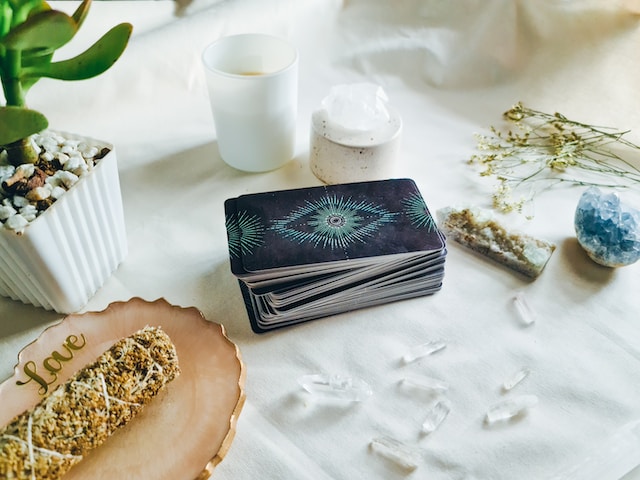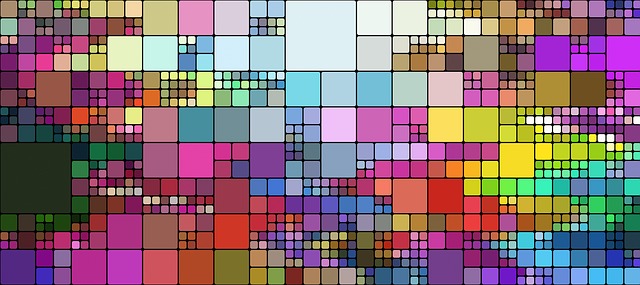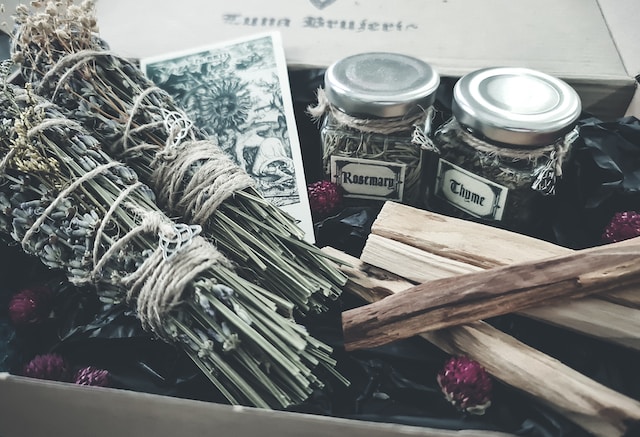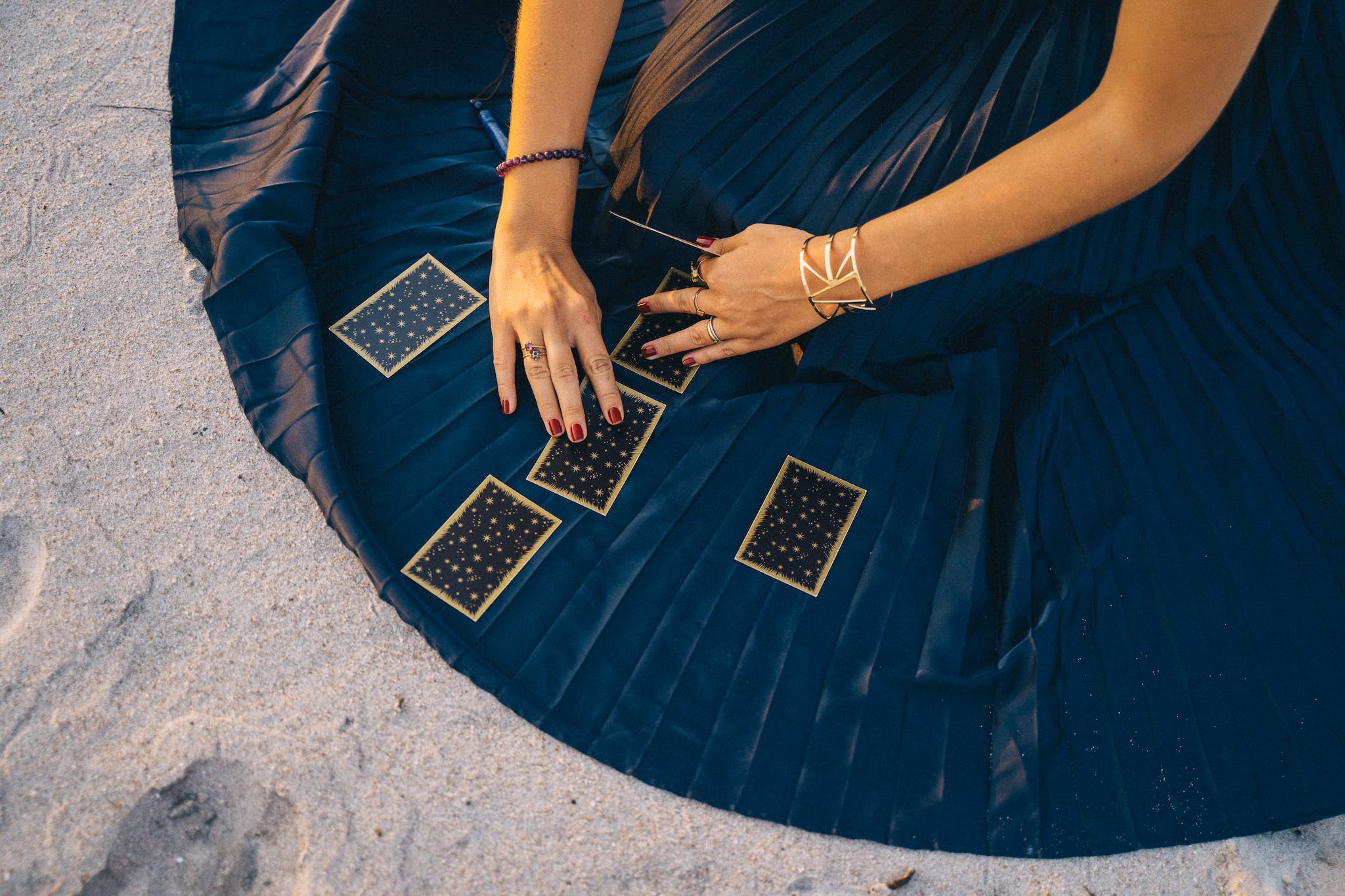Tarot For Beginners: A Comprehensive Guide To Getting Started With The Cards
There are some affiliate links below, but they are all products I highly recommend. For more info, view my disclosure here.
If you’ve ever been curious about tarot cards, you’re not alone. For centuries, people have turned to these mystical cards for guidance, self-reflection, and even entertainment.
Whether you’re seeking a deeper understanding of your inner-self or simply want to explore a new hobby, getting started with tarot can be both exciting and overwhelming. That’s why we’ve created this comprehensive guide to help you begin your journey into the world of tarot card reading.
In this article, we’ll break down the basics of tarot for beginners – from understanding the different types of decks to learning how to read and interpret the cards.
We’ll also discuss the history and symbolism behind the tarot, so you can truly appreciate its rich and meaningful origins.
So grab a cup of tea, settle in, and let’s dive into the captivating world of tarot together!
The Origins And History Of Tarot
Delving into the world of tarot can be an exciting and mystical journey, but it’s essential to understand its origins and history.
The tarot’s beginnings are shrouded in mystery and have been a subject of debate among historians for centuries. Some believe that the cards originated in ancient Egypt, while others argue that they came from medieval Europe. Regardless of their true origin, it’s undeniable that tarot has played a significant role in various cultures throughout history.
One popular theory suggests that tarot cards were first created in Italy during the 14th century as a card game called ‘tarocchi.’ This game gained widespread popularity across Europe, eventually evolving into the divination tool we know today.
The original deck contained four suits (cups, coins, swords, and wands), along with 22 trump cards known as the Major Arcana. These cards featured symbolic images rich with meaning that form the basis of modern tarot interpretation.
As interest in tarot grew over time, so did its symbolic imagery and spiritual significance. In the late 18th century, French occultist Jean-Baptiste Alliette – known by his pseudonym Etteilla – introduced an esoteric interpretation of the cards connecting them to ancient Egyptian mysticism.
This association with ancient wisdom imbued the tarot with a sense of mystery and spiritual power that continues to captivate people today.
Although many theories surround the true origins of tarot, one thing is certain: it has evolved significantly over time to become a powerful tool for self-discovery and personal growth.
Today’s modern decks offer countless variations on themes and imagery but still maintain their connection to historical symbolism. By understanding this rich history, we can appreciate how far tarot has come and better connect with its timeless wisdom as we embark on our own journeys through its mysterious world.
Choosing Your First Tarot Deck
The excitement of choosing your first tarot deck is truly unparalleled; it’s like stepping into a new world, filled with mystery and wonder.
Tarot decks come in a variety of styles, themes, and artistry – the options can be overwhelming at times! Fear not, for this section will guide you through the process of selecting the perfect deck to embark on your tarot journey. Remember that your connection with the cards is personal and unique, so trust your instincts as we explore the different factors to consider when choosing a tarot deck.
One key aspect to keep in mind while selecting a tarot deck is its imagery and artwork. The visual appeal plays an essential role since it helps you forge a strong connection with the cards. Browse through various decks and notice which ones resonate with you on an emotional or spiritual level. Do the images inspire curiosity? Do they evoke a sense of understanding or familiarity? Selecting a deck with artwork that speaks to you will make your tarot journey more enjoyable and intuitive.
Another factor to consider is the structure and tradition of the tarot deck. The most common system followed by tarot decks is the Rider-Waite-Smith (RWS) tradition, which serves as an excellent starting point for beginners due to its rich symbolism and easily accessible imagery. However, there are numerous other traditions like Thoth, Marseille, or even oracle decks that deviate from standard tarot structures.
As a beginner, it’s advisable to start with an RWS-based deck before delving into other systems. This foundation will allow you to better understand and appreciate alternative traditions in future explorations.
Choosing your first tarot deck might seem daunting initially but trust that your intuition will lead you towards the right choice for you. As you grow in your practice and understanding of tarot, remember this moment fondly: embarking on this incredible journey filled with self-discovery and spiritual growth. Your relationship with your tarot deck will be a personal and evolving one, so take your time, explore your options, and cherish the beginning of this magical adventure.
Understanding The Major And Minor Arcana
Picture yourself standing at the entrance to an ancient temple, ready to embark on a journey through the mysterious world of tarot. As you step inside, you are greeted by two paths: one leading towards the Major Arcana and the other towards the Minor Arcana.
In order to fully understand the language of tarot, it’s essential to grasp the significance and symbolism of each path.
The Major Arcana consists of 22 cards that represent significant life lessons and archetypal themes. These cards carry powerful messages and act as guideposts in your journey of self-discovery. When a Major Arcana card appears in your reading, pay close attention to its message, as it likely holds great importance in your current situation. Some key cards within this group include The Fool, representing new beginnings; The Lovers, signifying relationships; Death, symbolizing transformation; and The World, indicating completion.
On the other hand, the Minor Arcana is comprised of 56 cards divided into four suits: Cups (emotions), Swords (intellect), Wands (creativity), and Pentacles (material matters). These cards depict everyday situations and provide insight into our day-to-day experiences. Each suit corresponds to an element – water for Cups, air for Swords, fire for Wands, and earth for Pentacles – which can offer additional layers of meaning in your readings. For example, if you draw several Cups cards in a reading, it might indicate that emotions play a significant role in your current circumstances.
As you delve deeper into tarot practice, remember that understanding both the Major and Minor Arcana is crucial for unlocking its full potential as a tool for self-reflection and growth. By recognizing their distinct characteristics while also acknowledging their interconnectedness within readings, you will be well-equipped to navigate any situation that comes your way with clarity and wisdom.
So take a deep breath and embrace this remarkable journey through the realm of tarot, knowing that each card is a key to unlocking your own personal wisdom and self-discovery.
Familiarizing Yourself With Tarot Card Meanings
One of the most essential steps in learning tarot is familiarizing yourself with the meanings behind each card. There are 78 cards in a traditional tarot deck, and each one carries its unique symbolism and message.
To get started, it’s helpful to study the two main categories of cards: the 22 Major Arcana cards, which represent significant life events or spiritual lessons, and the 56 Minor Arcana cards, which depict everyday situations and emotions.
An effective way to begin understanding tarot card meanings is to work with one card at a time. You can start by focusing on the Major Arcana, as these cards tend to have more straightforward symbolism.
Look at the imagery on each card and take note of your initial reactions and feelings. Then research its traditional meaning, either through books or online resources. As you study each card’s symbolism and story, try connecting it with your life experiences or personal beliefs to deepen your understanding.
As you move on to explore the Minor Arcana, you’ll notice that they are divided into four suits: Cups (representing emotions), Wands (creativity and action), Swords (thoughts and intellect), and Pentacles (material possessions).
Each suit has ten numbered cards (Ace through Ten) and four court cards (Page, Knight, Queen, King). Understanding how these suits relate to different aspects of our lives will help you grasp their meanings when they appear in readings.
Committing all 78 tarot card meanings to memory may seem daunting at first; however, remember that practice makes perfect! Engaging with tarot regularly through daily single-card pulls or performing small spreads for yourself will help solidify your knowledge of each card’s meaning over time.
Additionally, connecting with others who share an interest in tarot can provide valuable insights into various interpretations of specific cards within different contexts—leading you toward a richer understanding overall.
The Art Of Tarot Card Spreads And Layouts
Now that you have a solid understanding of the meanings behind each tarot card, it’s time to explore how to effectively use them in a reading. The next step in your journey is learning about tarot card spreads and layouts. These are the arrangements of cards drawn from the deck, which provide context and help reveal answers to specific questions or situations.
In this section, we will delve into the art of crafting spreads and selecting layouts that best suit your needs. In Tarot readings, there are countless ways to arrange cards. However, some common spreads include the three-card spread, the Celtic Cross, and the Horseshoe spread.
The three-card spread is perhaps the simplest layout, where one card represents past influences, another for present circumstances, and a third for future possibilities. This spread is perfect for beginners or quick readings. On the other hand, more complex spreads like the Celtic Cross incorporate ten cards and offer deeper insights into various aspects of life such as relationships or career paths.
When creating a tarot spread or selecting a layout, keep in mind that different arrangements are better suited for different types of questions or issues at hand. For instance, if you’re seeking guidance on a specific decision or choice, opt for spreads that focus on pros and cons or potential outcomes like a two-path spread or decision-making layout.
Conversely, if you desire broader insights into your life as a whole or wish to explore current themes and energies at play, consider using comprehensive spreads like an astrological layout or elemental influences spread. As you continue your journey with tarot cards and experiment with various spreads/layouts during readings, you’ll develop personal preferences and discover what works best for you.
It’s essential not only to understand how each card’s meaning contributes to the overall message but also to consider how their positions within a given spread influence interpretation. Take time to practice with different layouts until you feel confident in both choosing appropriate spreads based on your queries and interpreting the cards within those arrangements. With patience and dedication, you’ll soon master the art of tarot card spreads and layouts, enhancing your readings and further deepening your connection with the cards.

Developing Your Intuition And Interpretation Skills
As you delve deeper into the world of tarot, it’s essential to develop your intuition and interpretation skills. These abilities will not only help you connect with the cards on a more profound level but also enhance your readings’ accuracy and meaning. Trusting your instincts and understanding the symbolism behind each card will allow you to provide insightful guidance for yourself or others during a reading.
One way to strengthen your intuition is through regular practice. Give yourself time each day to sit quietly with your deck, drawing one or two cards at random and reflecting on their meanings. Pay attention to any initial feelings or impressions that arise as you look at the images on the cards.
It’s okay if these feelings are vague or unclear at first; over time, your intuition will sharpen, and you’ll be able to discern more specific messages from the cards.
In addition to daily practice, consider keeping a journal in which you record your thoughts, feelings, and interpretations of each card drawn. This process can help solidify your understanding of the tarot deck while also allowing you to track patterns or recurring themes in your readings. Reviewing past entries can provide valuable insights into how well you’ve grasped the essence of each card and highlight any areas where further study may be beneficial.
Developing strong interpretation skills is equally important for successful tarot readings. Familiarize yourself with common tarot symbols such as colors, numbers, animals, and elements by studying traditional meanings associated with them. However, remember that personal associations hold equal importance when interpreting a card’s message within a specific context or question.
By nurturing both intuitive abilities and symbolic knowledge, you’ll become a confident reader who can easily navigate the intricate landscape of tarot cards without feeling overwhelmed or uncertain about their messages.
Tips For Conducting Your First Tarot Reading
As you continue to hone your intuition and interpretation skills, you’ll naturally feel more confident in your abilities as a tarot reader. This newfound confidence will undoubtedly help you as you venture into conducting your first tarot reading.
In this section, we’ll explore some useful tips to keep in mind, ensuring that your initial foray into the world of tarot is as smooth and enjoyable as possible.
First and foremost, it’s essential to approach your first reading with an open mind and heart. You may not get everything right on your first try, but that’s okay! Remember that tarot reading is a journey of self-discovery and learning.
Be patient with yourself and trust in the process. It’s also helpful to create a peaceful environment for your reading – think about lighting candles or burning incense to set the mood and clear any negative energies from the space.
Before you begin shuffling the deck, take a moment to ground yourself. Close your eyes, take a few deep breaths, and focus on connecting with your intuition.
Once you feel centered, ask the question you’d like guidance on – whether it pertains to love, career, personal growth, or something else entirely. Keep this question at the forefront of your mind as you shuffle the cards; when you’re ready, draw one or more cards (depending on which spread you’re using) and place them face-up in front of you.
Now comes the exciting part: interpreting what these cards are trying to tell you! Keep in mind that each card has multiple meanings depending on its position within a spread; use both traditional interpretations found in guidebooks alongside your intuition when deciphering their messages.
As an added bonus tip: consider keeping a tarot journal where you can record details of each reading – including date, question asked, cards drawn and their positions – along with any insights or revelations gleaned from them.
This practice will not only help solidify your understanding of the cards but also serve as a valuable tool for tracking your growth and progress as a tarot reader.
As you delve into the world of tarot, remember that it’s essential to trust your intuition and develop a personal connection with the cards.
Keep an open mind, practice regularly, and allow yourself to grow as a reader.
Don’t be afraid to make mistakes or ask for guidance along the way.
Embrace the wisdom and insights that tarot has to offer, and enjoy discovering the many layers of its symbolism and meaning.
Wishing you all the best in your tarot journey!






